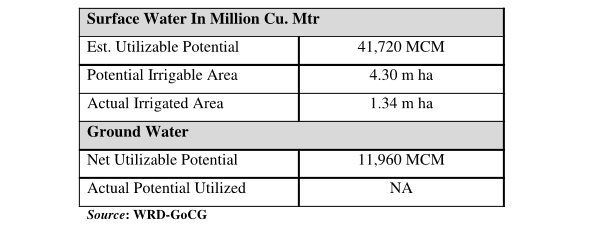Water is a prime natural resource, a basic human need and a precious national asset. Planning, development and management of water resources need to be governed by national perspectives.
India accounts for about 2.45 per cent of world’s surface area, 4 per cent of the world’s water resources and about 16 per cent of world’s population. The total water available from precipitation in the country in a year is about 4,000 cubic km. The availability from surface water and replenishable groundwater is 1,869 cubic km. Out of this only 60 per cent can be put to beneficial uses. Thus, the total utilisable water resource in the country is only 1,122 cubic km.
Chhattisgarh has sufficient water resources and a large untapped potential. Utilizable surface water potential in the State, if properly harnessed, can irrigate an estimated 4.3 m ha area, against the existing irrigation potential of 1.38 m ha.
Potential & Utilization of Water In Chhattisgarh Surface Water In Million Cu. Mtr Est. Utilizable Potential 41,720 MCM Potential Irrigable Area 4.30 m ha Actual Irrigated Area 1.34 m ha Ground Water Net Utilizable Potential 11,960 MCM Actual Potential Utilized NA Source: WRD-GoCG
Potential & Utilization of Water In Chhattisgarh
Estimated surface water flowing through rivers of Chhattisgarh is 48,296 Million Cum. and due to various geographical and interstate constraints the usable surface water in the state is 41,720 Million Cum. Surface water being used at present is only about 18,249 Million Cum.
Estimated ground-water in the state is 14,548 Million Cubic meters and present exploration is about 18.31%.
There are four main sources of water:
(i) Surface water
(ii) Underground water
(iii) Atmospheric water, and
(iv) Oceanic water
(i) Surface water
Water found on the surface is called surface water. About two – third of the total surface water flows into three major rivers of the country – Indus, Ganges and Brahmaputras. The water storage capacity of reservoirs constructed in India so far is about 17400 billion cubic metres. At the time of independence, the water storage capacity was only 180 billion cubic metres. Hence water storage capacity has increased about ten times.
India’s average annual surface run-off generated by rainfall and snowmelt is estimated to be about 1869 billion cubic meter (BCM). However, it is estimated that only about 690 BCM or 37 per cent of the surface water resources can actually be mobilised. This is because (i) over 90 per cent of the annual flow of the Himalayas rivers occur over a four month period and (ii) potential to capture such resources is complicated by limited suitable storage reservoir sites.
(ii) Underground water
It refers to all water below
the water table to great depths. In the soil, both water and air coexist in the pore spaces. A profound consequence is that the capillary water in the soil can only be extracted by plant roots, within certain range of conditions. Ground water, on the other hand can be extracted by humans through wells. Ground water and soil water together constitute the lower part of the hydrological cycle. The annual potential natural of ground water recharge from rainfall in India is about 342.43 km3 , which is 8.56% of total annual rainfall of the country.Underground water is used on a large scale in the areas where the rainfall is comparatively less. Underground water is used on a large scale in Punjab, Haryana, Rajasthan, Tamil Nadu, Gujarat and Uttar Pradesh whereas Andhra Pradesh, Madhya Pradesh, Maharashtra, Karnatake and Chhattisgarh are such states where inspite of less rainfall, the use of underground water is less. There is a great need to develop underground water resources here.
(iii) Atmospheric water
Evaporation and transpiration change liquid water into vapor, which ascends into the atmosphere due to rising air currents. Cooler temperatures aloft allow the vapor to condense into clouds and strong winds move the clouds around the world until the water falls as precipitation to replenish the earthbound parts of the water cycle. About 90 percent of water in the atmosphere is produced by evaporation from water bodies, while the other 10 percent comes from transpiration from plants.
(iv) Oceanic water
The Ocean plays a key role in this vital cycle of water. The ocean holds 97% of the total water on the planet; 78% of global precipitation occurs over the ocean, and it is the source of 86% of global evaporation. Besides affecting the amount of atmospheric water vapor and hence rainfall, evaporation from the sea surface is important in the movement of heat in the climate system. Water evaporates from the surface of the ocean, mostly in warm, cloud-free subtropical seas.
CGPCS Notes brings Prelims and Mains programs for CGPCS Prelims and CGPCS Mains Exam preparation. Various Programs initiated by CGPCS Notes are as follows:-